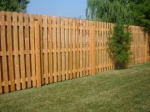
"Good fences make good neighbors," as the saying goes. Fencing is a central element of many yard and garden designs, both for functional and aesthetic reasons. However, for those looking to install a new fence, it quickly becomes apparent how widely prices can diverge. One reason for the wide price variation comes down to material. With numerous types of fencing available, different models come with different price tags. In addition, the installation cost can vary, depending on the contracting company one hires and the difficulty of installation. Before selecting a particular fencing solution, it’s a good idea to survey the range of options available, both in terms of pricing and long-term value.
The first factor in determining fencing cost is the fence material. With fences ranging widely in their construction, from wooden slats to chain-link fencing, the type that you select will largely determine the final price. Wooden fences may come in a range of more specific styles, including picket fences, split rail fences, and double-sided "privacy" fences. Vinyl fences, sometimes produced to mimic the look of wood, are another popular fencing material. For fences allowing more visibility, many playgrounds or ballparks use chain-link fencing.
Wooden fences, valued for their classic appearance, also offer relatively moderate prices, with figures largely depending on the type of lumber used and the intricacy of the design. A wooden fence for a residential property might cost anywhere from $518 to $1907. A picket fence, often associated with the classic "Americana" home, is typically a mid-range option. It consists of vertical fence posts, driven into the ground; long, horizontal slats; and upright pickets, which are affixed to the slats. For a simpler and less expensive design, split rail fences are a rustic alternative. Evoking a ranch-style or "Wild West" aesthetic, these fences consist of rounded logs that are split length-wise. The split logs (or "rails") are then affixed together in a relatively open pattern. As a result, materials costs are usually lower. In addition, the fence offers greater visibility, making it ideal for properties where privacy is of little importance. In more suburban or urban areas, wooden fences may be constructed with two layers for maximum privacy. In these designs, the upright wooden slats are arranged so that it is impossible to peek between the chinks in the wood. Given their design, these privacy fences are typically more expensive, both for the materials and the installation cost.
After wood, metal is perhaps the material most associated with fencing. While metal fences are sometimes considered less aesthetically appealing and associated with industrial or urban areas, in fact the range of metal fence designs is quite wide-ranging. A decorative metal fence, on average, costs more than a wooden one, with average prices ranging between $827 and $2188 nationwide. One benefit of a metal fence is its robust construction and durability. While wooden fences may wear or discolor due to weathering, a well-built metal fence should last far longer without suffering damage. Given their strength, metal fences are also popular for protective fencing, such as around pool enclosures or raised patio areas. More ornate examples of metal fences include wrought iron fences, often integrated into romantic architectural schemes. At the other end of the spectrum, chain link fencing is about the most utilitarian form of metal fencing. While it rarely qualifies as a design element, it can enhance a yard or garden simply by blending into the background. In addition to metallic chain-link fencing, some such fences are coated with a vinyl or plastic coating. When done with green vinyl, these fences are effectively camouflaged, blending in with the plants.
Chain-link fences aren’t the only form of fencing that incorporates vinyl elements. All-vinyl fences are a popular alternative to wood or metal, both for their resilience to weathering and their flexibility in color and design. A vinyl fence of around 25 feet costs between $440 and $2114 on average, making it more expensive than wood, but in many cases, also longer-lasting. Vinyl fencing is also among the most flexible option in appearance. Instead of painting and repainting a wooden fence, homeowners can simply select a vinyl fence in the color of their choosing. Likewise, vinyl fencing that is molded into lattices or other forms may prove far more economical than intricately latticed wooden fencing.
Aside from materials, the next factor influencing your fence’s cost is its dimensions. Higher fences, necessary if privacy is desired, naturally cost more than lower ones due to the increased quantity of material needed. In addition, a taller fence may require a sturdier support system, requiring that posts extend further downward into the ground. The fence’s length will also influence its overall cost. For example, one way of reducing fencing costs is to carefully map out your fencing needs. Instead of investing in a perimeter fence for an entire yard, it may be possible to make use of outbuildings or thick hedges to reduce the total yardage of fencing required. Overall, fences of 20 to 100 feet cost an average of $774. Fences of 100 to 200 feet average $1270.
In general, it’s often possible to reduce fencing costs by slightly adjusting your fencing materials, shape, or size. In addition, depending on whom you hire, different fencing and contracting companies may vary in their installation costs. Whatever your priorities in selecting a fence, though, it would be a mistake not to weigh in durability. In some cases, a more durable fence will cost more upfront, but will last far longer, making it a better overall value.
